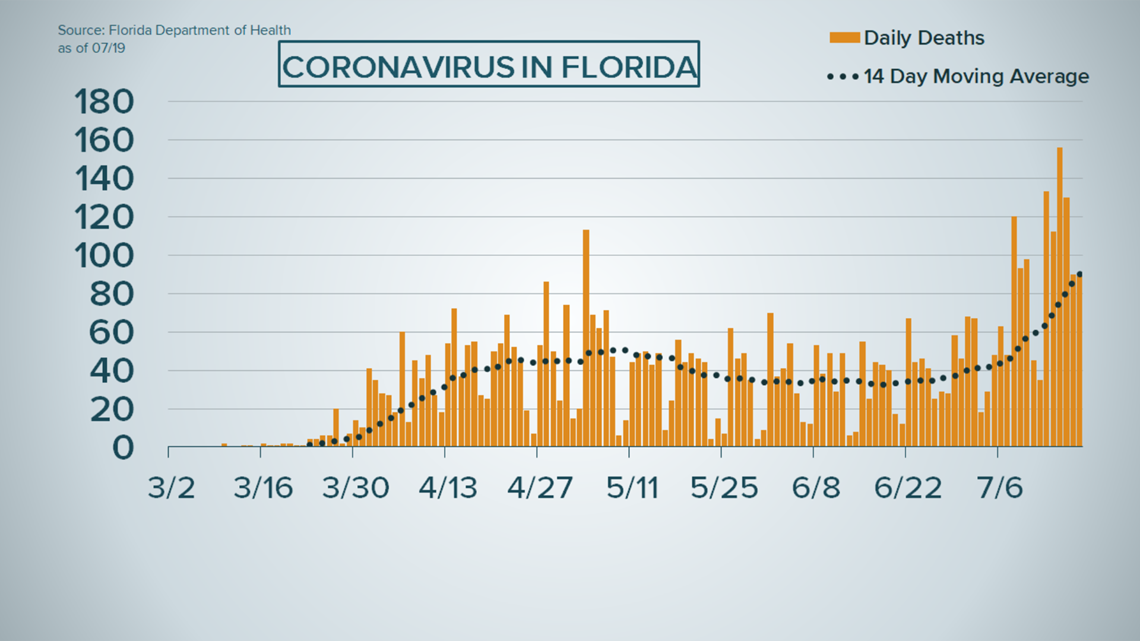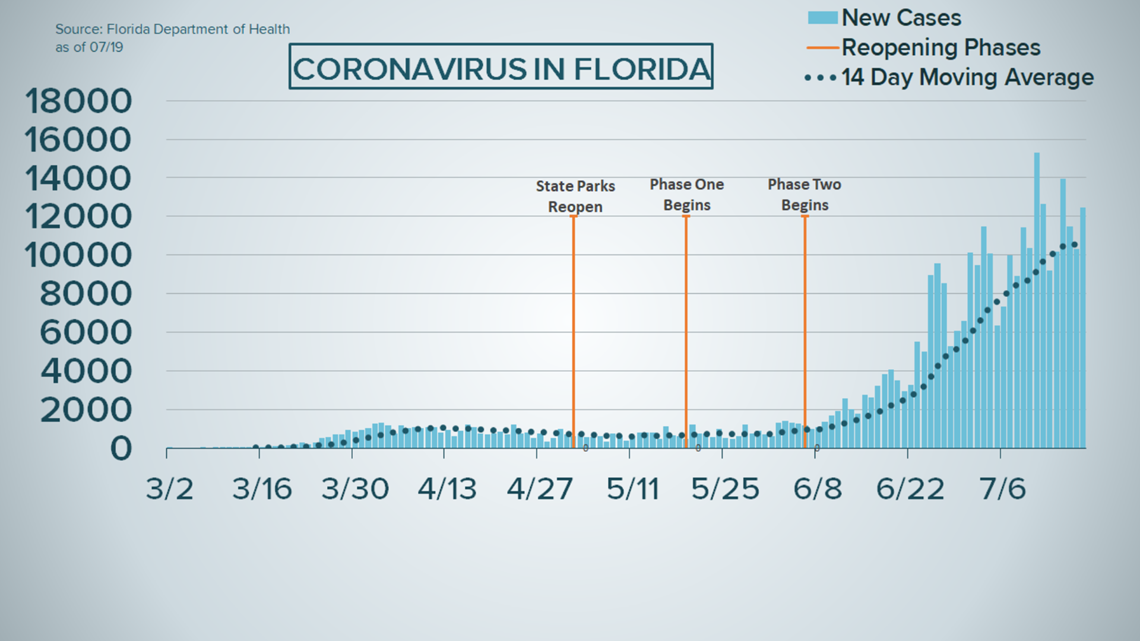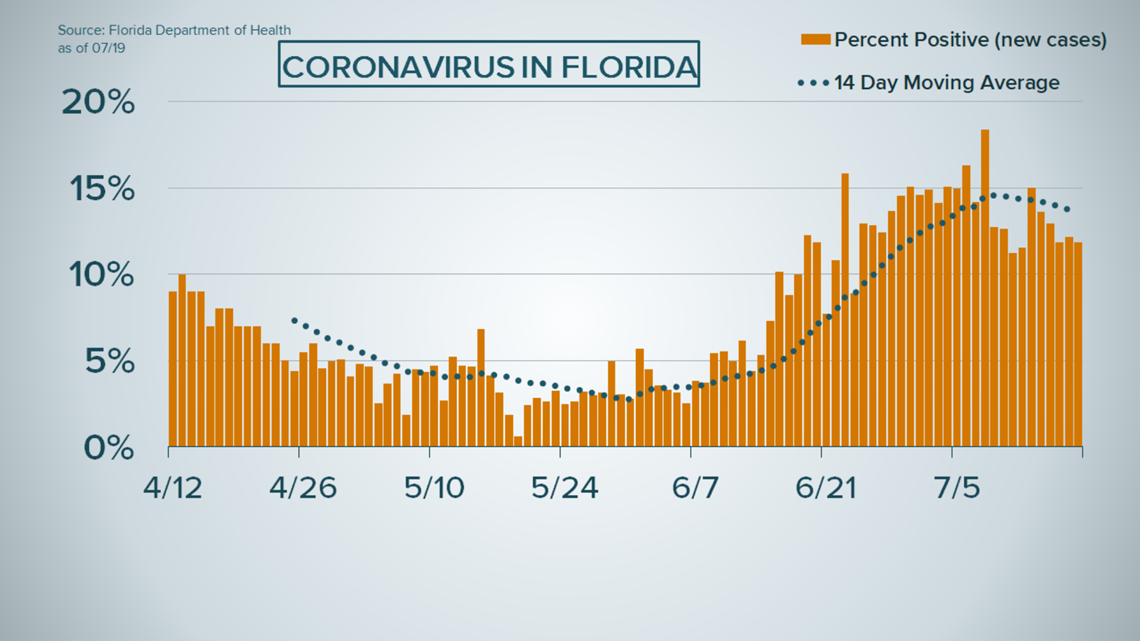Sunday's report from the Florida Department of Health showed another 12,478 new COVID-19 cases added to the state's total.
There have now been 350,047 positive cases of the virus statewide since March. As of Sunday, the median age of Florida residents testing positive is 41, which has been roughly the trend for several days.
The Florida Department of Health also confirmed another 87 Floridians have died after testing positive for coronavirus, bringing the total number of COVID-19-related deaths in the latest report to 4,982 Floridians. There have also been another two non-resident deaths, bringing the total to 109 non-resident deaths statewide since the pandemic began.
Overall, 5,091 people have died in Florida.
That doesn't necessarily mean those most recent 89 individuals died on July 18 -- rather that the state learned of their deaths and added them to the total that day. The state's daily line-by-line report, which you can read here, lists coronavirus deaths by the date the people tested positive for the virus, not the date they passed. In contrast, our chart below shows deaths by the date they were added to the state's report.


When it comes to testing, Sunday's report showed 115,149 test results were turned in on July 18. Out of those tests, 11.85 percent were positive.
When it comes to hospitalizations, 9,229 people in Florida were hospitalized with coronavirus as their primary diagnosis as of Sunday morning. In the Tampa Bay area, 1,865 were in the hospital.
A total of 20,971 people have been hospitalized in Florida at some point during the pandemic.
Here's a breakdown of the new coronavirus cases reported to the state by day:
- June 21: 2,926
- June 22: 3,286
- June 23: 5,508
- June 24: 5,004
- June 25: 8,942
- June 26: 9,585
- June 27: 8,530
- June 28: 5,266
- June 29: 6,093
- June 30: 6,563
- July 1: 10,109
- July 2: 9,488
- July 3: 11,458
- July 4: 10,059
- July 5: 6,336
- July 6: 7,347
- July 7: 9,989
- July 8: 8,935
- July 9: 11,433
- July 10: 10,360
- July 11: 15,300
- July 12: 12,624
- July 13: 9,194
- July 14: 10,181
- July 15: 13,965
- July 16: 11,466
- July 17: 10,328
- July 18: 12,478


Breaking down the numbers
There has yet to be a day in July where the number of newly-confirmed cases was fewer than 6,000. In fact, the last time that happened was on June 28.
Tuesday's report for July 13 was the first time the single-day case number was fewer than 10,000. Wednesday's report for July 14 saw the single-day number jump up to 10,181.
Thursday's report for July 16 saw the second-highest number of confirmed cases at 13,965.
The highest single-day case number Florida has reported so far is 15,300 for July 11.
The World Health Organization and infectious disease experts around the globe have recommended a positivity rate of 5 percent or lower for a 14-day span in order to be comfortable reopening.
Florida has not seen a positivity rate at 5 percent since the beginning of June. For more than a month, the state has reported positivity rates at double and even triple that recommended percentage.
Florida remains in Phase Two of reopening, which began June 5.


Hospitalizations and ICU bed availability
Cases are climbing, but what about hospitalizations?
Tracking hospitalizations got easier on July 10 when the Agency for Health Care Administration began publishing a spreadsheet with the number of people currently checked-in for coronavirus-related complications in Florida. The data only includes people whose "primary diagnosis" was COVID-19.
As of 10:15 a.m. Sunday, 9,229 people were hospitalized with COVID-19 as their primary diagnosis statewide, and 1,865 of them were in the Tampa Bay area. Those numbers are frequently updated, and you can click here for the most recent data, which is also broken down by county.
Since the pandemic began, the state confirms a total of 20,971 residents were hospitalized at some point during their illness.
The Agency for Healthcare Administration (AHCA) also updates total hospital bed and ICU availability by county.
Click here for a breakdown of adult and pediatric ICU bed availability by county. You can also check ICU availability by the hospital.
Hospitalizations around Tampa Bay and total staffed hospital bed capacity status:
**Data as of 10:15 a.m. on July 19
Citrus:
- 30 COVID-19 hospitalizations
- 99 of 324 total staffed hospital beds are available
DeSoto:
- 5 COVID-19 hospitalizations
- 27 of 55 total staffed hospital beds are available
Hardee:
- 0 COVID-19 hospitalizations
- 1 of 25 total staffed hospital beds are available
Hernando:
- 91 COVID-19 hospitalizations
- 209 of 738 total staffed hospital beds are available
Highlands:
- 61 COVID-19 hospitalizations
- 60 of 254 total staffed hospital beds are available
Hillsborough:
- 551 COVID-19 hospitalizations
- 788 of 3,890 total staffed hospital beds are available
Manatee:
- 112 COVID-19 hospitalizations
- 125 of 793 total staffed hospital beds are available
Pasco:
- 127 COVID-19 hospitalizations
- 267 of 1,368 total staffed hospital beds are available
Pinellas:
- 458 COVID-19 hospitalizations
- 510 of 2,844 total staffed hospital beds are available
Polk:
- 273 COVID-19 hospitalizations
- 406 of 1,691 total staffed hospital beds are available
Sarasota:
- 157 COVID-19 hospitalizations
- 249 of 1,225 total staffed hospital beds are available

